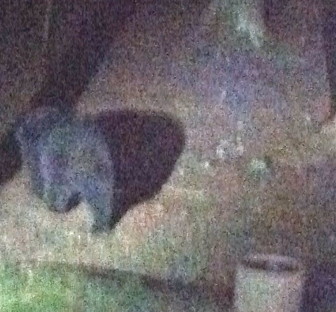After at least five sightings of black bears in town between last April and September, the head of the New Canaan Police Department’s Animal Control section is notifying residents now that they should expect to see the species again soon.

This black bear was spotted on the night of April 4, 2015 out back of a Marvin Ridge Road home in New Canaan. Credit: Craig Hunt
The young males spotted last summer gave Officer Allyson Halm the impression that they’re passing through this area, and New Canaanites likely will see more of them as spring approaches, according to Officer Allyson Halm.
“They could become a more permanent fixture here,” said Halm, who spotted a black bear loping across Cheese Spring Road last summer, just days into the job.
The omnivorous mammal had been spotted on Weed Street in October 2014 and then made headlines in New Canaan last April, when a family (rescue) dog alerted his family to a black bear that had entered the rear porch of a residence. After a black bear was spotted in June on Thayer Pond Road, officials urged New Canaanites to ensure their garbage cans and birdfeeders were secured, town officials issued a list of do’s and don’ts. A final sighting occurred in Hoyt Farms in September.

Here’s the black bear spotted around 8 p.m. on June 26, 2015 in the area of Thayer Pond Road. Contributed photo
State officials say the evolution of farmland in Connecticut into forested areas near the turn of the 20th century created conditions favorable to black bears.
“Beginning in the 1980s, the DEP Wildlife Division had evidence of a resident black bear population” in Connecticut, according to the state Department of Energy and Environmental Protection.
“The mere presence of a bear does not necessitate its removal,” the DEEP says. “In most cases, if left alone, the bear will make its way to a more natural habitat. Removing food attractants, such as bird feeders, reduces the chance that bears will go near homes.”
The animals typically breed in the summer, and cubs are born in January and February. At two years old, the young bears typically leave their mothers and the males especially will begin to travel great distances to stake out their territories.
According to Halm, those of the very bears that New Canaanites saw last year and will see again this spring.
“I was under the impression that they’re young males that are sort of roaming through,” she said.
New Canaanites can take a number of steps to ensure that they keep roaming, should the mammals pass near their homes, she said.
“Birdfeeders are a huge attraction,” Halm said. “But it’s going to be extra effort and steps to take a birdfeeder in at night. And if you are careless with garbage, you will have a bear.”
The animals are opportunists, like coyotes, though not as predatory, Halm said.
“They are not out to kill anything to eat, but happy to [do so] if they stumble across it,” she said.
A black bear that becomes habituated to food made available to it by humans also will relocate, Halm said, meaning it would need to be dispatched.
“A fed bear is a dead bear,” she said.